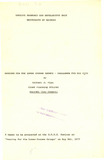| dc.description.abstract | HOUSING THE LOWER INCOME GROUPS - CHALLENGE FOR THE ClTY
I
The views expressed in this paper are those of the author
and do not reflect. Council's opinions in any "ray.
Over the past decade the City Council of Nairobi has
wrestled with the problem of housing the ever increasing
population of the city. The city however,has not
achieved her goal of adequately housing all the families
resident within her boundaries. The failure is not so
much attributable1to l~ck of concern and attention on the
part of the Council but to the combination of rapid growth
and a relatively meager resource base including varying
standards and philosophies.
This paper will outline Council's experience and achievement
in the housing of the 16t·yerincome: groups. It will further
highlight, the contradictions in policy and the factors that
inevitably influence Council's policy in the field of housing.
During the colonial period; the urban population of the
city was mainly made up of male migratory workers who left
their "lives and familles in the rural areas. Their movement
to the city was tightly controlled and only those who were
gainfully employed were permitted to reside in the city.
Besides, th~ level of "rages was such that fe",could support
a family in an urban area. These factors accounted for the Lower
rate of population growth within this period as ,,,ell
as the skewed sex ratio and the relatively small household
sizes characteristic of the time. Unemployment was nonexistent
and there was a balance population and jobs.
The population structure pertaining at the time had a great
impact on housing provision in the city for the African
workers. The Europeans and Asians do not fit this model
as they were of higher income brackets and low cost housing
was irrelevant in their case. The main thrust for low
income municipal housing was to accommodate Africans. However , there were a few schemes for European and Asian
Low Income population such as Wodley and Pangani.
The system of administration largely i9nored the African
population anc had accorded it little say in the conduct
of urban affairs. At best, Africans were reregarded as
"wards of urban authorities rather than as citizens.
This explains the relative disparity in the provision of
services between various racial groups that resided in the
city.
The African estates were to house single males who were
later to return to their respective places of origin in
the rural areas. The units constructed then were simple
rooms shared facilities in which individuals were allocated
bed spaces. The rents therefore were very low and
could be easily be afforded by the Lower income population
of the time. But even in those early days a need existed
to house family units in the city, albeit at a very low
level. This led the Council to develop family units in
Kaloleni; but the experiment 'was not repeated elsewhere. ..................................................... | en_US |



